I recently returned from a 10-day research trip to the UK, where I was gathering material for three upcoming novels. In both my work as a historical romance author and a technical communicator, my job is the same: explaining complicated things to people and getting people to care about complicated things. Whether you’re an engineer, a history lover, a romance reader, or some glorious combination of all three, this series is for you.
Brewing Series:
Article 1: Everything is Beer
Brewing is such a sensory experience – the smells and sounds, the colors, the hidden dangers, and unwritten cant. Historic brewing has even more facets. Understanding Victorian brewing requires asking questions you don’t know you should ask.
There is one brewery in the U.S. that uses 19th-century equipment and methods. It’s in Dayton, Ohio. The UK and Ireland have a dozen or so. In researching where to go, I learned a funny thing – flying to Dayton from Oklahoma and flying to London from Oklahoma costs about the same. I mean no disrespect to Dayton and Ohioans in general, but I chose London. I expanded the scope of my research beyond brewing and took the leap.
And when I say took the leap, I mean: saved for three years, met with an accountant, created an LLC for my writing, read about a few dozen books, coordinated around school holidays, and cajoled the grandparents for help.
Sambrook’s Brewery
The first brewery I visited was Sambrook’s in London. Formerly Young & Co.'s Brewery— and other breweries before that — Sambrook’s sits on the oldest continuously brewed site in the UK. Ale and beer have been brewed here since the reign of King Henry VIII.
John Hatch, Sambrook’s head brewer, was very kind to spend a morning going through the historic part of the brewery with me. Situated in Wandsworth, London, a Thames canal once ran directly alongside the brewery to deliver malt and hops and carry away casks of beer and ale. The canal has since been diverted, and posh buildings and a sushi restaurant now surround the complex.
With John as my guide, I ventured into the world of historic brewing.
This is the site's original well. Dug in 1533 and modernized by the Victorians, it was taken out of use when the city decided to start taxing Young’s for using their own water. So enraged, the owner physically destroyed the pump to prove they were not using the well. It reminded me of the research I did on whisky for my first book. Just like whisky, the trajectory of beer and ale has been undeniably shaped over the century by taxes.
Brewing has a language all its own. Liquor is the brewer’s term for water. This isn’t simply a linguistic flourish. Liquor can refer to plain old water from a well or tap, or treated water. Before the mid-1800s, certain beers could only be brewed in certain places because of the characteristics of the water. Burton upon Trent had particularly perfect water for brewing pale ale that was sharp, fresh, and extra hoppy. Samuel Allsopp realized that it was the region’s sulfite-rich water that made the difference. By adding sulfite in the form of gypsum to his water, he could mimic Burton Upon Trent’s water. This became known as Burtonisation.

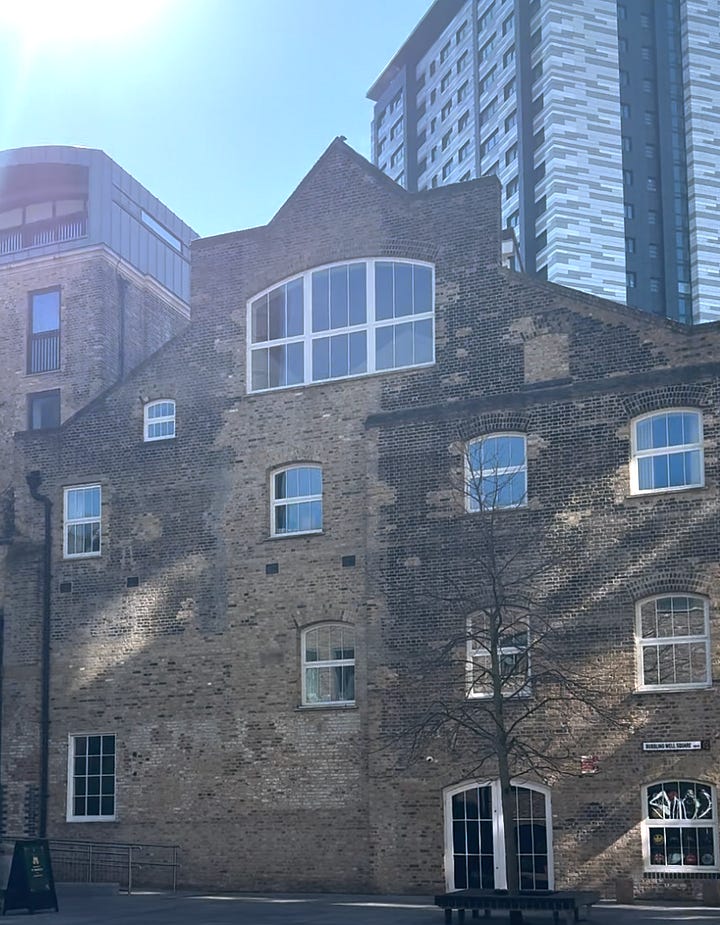
There are two key markers for spotting a historic brewery. The first is that it will be a tall building. Historic breweries were built like towers to make use of gravity. Jacobs Ladders would move the materials to the top and then gradually move them, step by step, to the ground floor. The second marker is a smoke stack. Brewers used a lot of steam.
Sambrooks’ now-quiet courtyard would have once been a loud, busy, and dangerous place. Imagine the model of the original brewery complex (above) mixed with the bustling scene from his historic image of the Guinness Brewery (below). You would have seen casks piled 30 feet high, enormous dray horses, and ships coming and going.

Among the most impressive items in at Sambrook’s are the Coppers. These kettles were used to boil the wort.
We need to pause quickly to talk terms. Remember when I said that brewing has a language all its own? Here’s a quick, very generalized, slightly incomplete rundown of how one ingredient can have approximately 400 different names.
Here are the many names for barley in the brewing process. I’ll bold them to help you track.
Barley starts as Barley. The grain is malted by first soaking it in water until it germinates and then drying it. This process activates natural enzymes that convert starches into fermentable sugars. The rootlet (the sprouted shoot) is removed. Now the barley is Malt.
Next, it’s milled into fine pieces in a grist mill. The malt is now Grist. Hot liquor (aka water) is added, turning the grist into a porridge-like consistency called Mash. The Mash is held at specific temperatures in a mash tun to allow naturally occurring enzymes to break down the starches into sugars. (Fun fact, beers are classified by an extra X every time they are cycled through the mash tun. XX beers are cycled through twice, XXX three times, etc., hence the name of Dos Equis beer).
The Mash is then sparged by adding fresh liquor to the mash. This washes the sugars, flavors, and colors from the mash. After this now-fermentable liquid is separated from the mash and strained, it is called Wort.
(The leftover Mash, now called Spent Grain, is sold to farmers as a nutritious and tasty livestock feed.)
Vocabulary lesson over. Back to the Coppers and the wort.
The wort is boiled in these giant copper kettles, fittingly called Coppers. Copper is an ideal material because it conducts heat evenly and responds quickly to changes in temperature, which are vital for precise control of the boil. The outside of the Coppers would have been polished daily because shiny copper retains heat better.
One of the things we take for granted is pressurized water. Without it, Victorian brewers had to have men clean the Coppers by hand daily. It was a terrible job, as the inside of the Coppers were usually more than 110° F.
The Wort is typically boiled for about an hour, sometimes longer, and a vigorous boil is ideal. It’s during this stage that the Hops are added, either all at once or at different times depending on the type of beer.
From there, the wort is cooled in a shallow tub called a wort ship or coolship. If you scroll up to the picture of Sambrook’s exterior, you’ll notice a long, arched window at the top. This is where the wort ship was located. All the windows would be opened to let the wort cool quickly. (I’ll show you a picture during the Hook Norton tour below). After it’s sufficiently cooled, yeast is added to ferment the liquid and officially transform it to beer. Next it’s stored until it reaches the correct color, aroma, and alcohol content. Finally, it’s casked, where it undergoes a second fermentation over time.
Casks are another area of linguistic precision. Casks are casks — the wooden containers. Barrels are a specific size of casks — 36 gallons or 288 pints, to be specific. Don’t call a cask a barrel in front of a brewer. Barrels aren’t the only other size of casks; they range from a tun all the way down to a pin. If you’re a Harry Potter fan, you’ll recognize the inspiration for the name of a favorite gathering place in Hogsmeade.

John and I ended our tour at Sambrook’s taproom, where I enjoyed a hoppy glass of gluten-free beer brewed right there at Sambrooks.
Hook Norton Brewery
About a week after visiting Sambrook’s, I made my way from Northamptonshire (where I was visiting an archeological dig…which I wrote about here) to visit the historic Hook Norton Brewery in Oxfordshire. Unlike at Sambrook’s, Hook Norton’s brewery still uses most of their original equipment.
Since you now know how to spot historic breweries, you’ll probably immediately notice the building’s shape and the large smokestack. Designed by famed architect William Bradford and opened in 1848, Hook Norton Brewery is one of England’s best examples of a classic tower brewery.
Inside, they offer this handy diagram to help visitors understand what is happening where during the two-hour tour. Like I said earlier, tower breweries make use of gravity, moving everything up and then working their way down.
Everything in the brewery was once run by steam. In fact, steam is one of the reasons it took 8 casks of water to make every cask of finished beer. Though not routinely operated anymore, almost the entire brewery could still be run by the steam engine powering the Jacobs Ladder system that snakes through the building.


The window behind the engine reminds me of something interesting I learned from John at Sambrook’s. Many of the windows at both Hook Norton and Sambrook’s were not always windows. Some still aren’t, even if they might look like an ornamentally framed window from a distance. The reason, of course: taxes. During 19th-century England, there was a window tax. This birthed the phrase “daylight robbery.”
These gauges are still used to measure the amount of liquor in the tanks. I also included it so you can see my very fancy method of labeling pictures on the fly. Our tour guide, whose name I sadly didn’t write down, was incredible.
This is not just a grist mill, it is the grist mill. The only grist mill Hook Norton has ever had.
One of the themes throughout the tour was that the original Victorian-era equipment often still worked. The new equipment, usually forced upon them by modern food-safety standards, often breaks after just a few years.
The mash tun is, as we learned in the Sambrook’s tour, where grist meets liquor to become mash and is then sparged with fresh liquor to create wort.
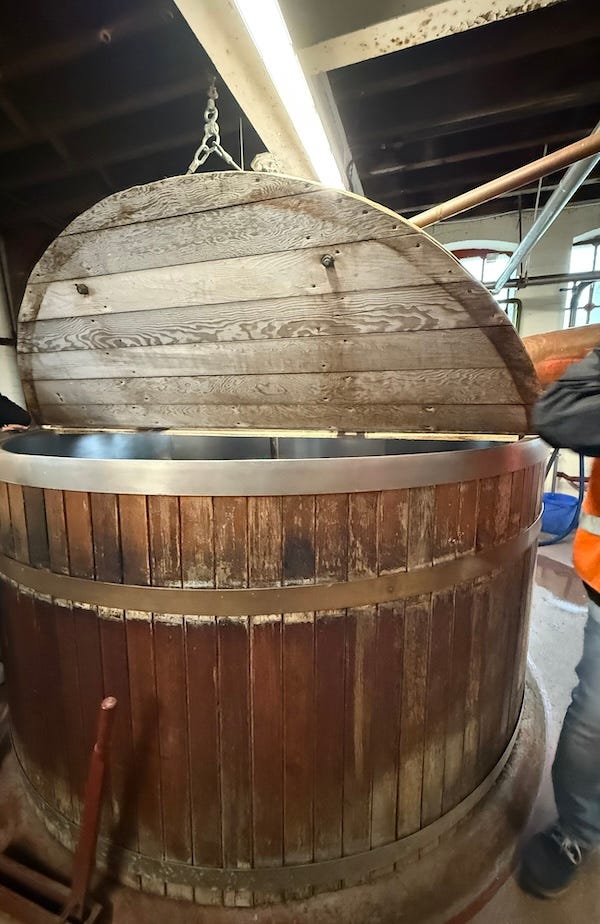

Hook Norton still has its wort ship in place, though they can no longer use it. Something about food safety and pigeon droppings in the slats of the open windows that would have originally let in the breeze.
Wort ships didn’t just originally cool the wort. This was where the magic happened — where the liquid met natural yeasts and bacteria in the air to begin the fermentation process. This (and the water) is why regional beers had such distinct tastes.
Read The Meaning of Beer by Jonny Garrett to see how hunting down regional yeast birthed germ theory. More on that in the fourth article in this series, where I’ll look at transferable technology.
Hook Norton isn’t just a historic place, it’s active in its own community and far outside it. At the end of our tour, when we went to visit the now-retired dray horses, our guide showed us a quite normal-looking pickup truck that will soon have a useful future.
The village of Hook Norton, our guide explained, has a community of Ukrainian refugees. The brewery is doing everything it can to support Ukraine, and not just with lip service. They take annual trips to Ukraine, delivering vehicles, ambulances, food, aid, and (one presumes) some damn good beer. That truck was destined for their next trip.
Like I said in my preamble article, the more I learned about beer, the more I began seeing it in every facet of life, of history, and of our future. Sambrook’s and Hook Norton’s proud legacies and exciting futures are proof of beer’s important place in society.
I look forward to continuing this beer series. Next up, Women, Witches, and Wort — about how ale has been used in history to elevate and subjugate women. Make sure to subscribe to get it in your inbox.
For the Curious & Captivated
Visit Article 1 of this series, which reviews some of my favorite beer and brewing resources.





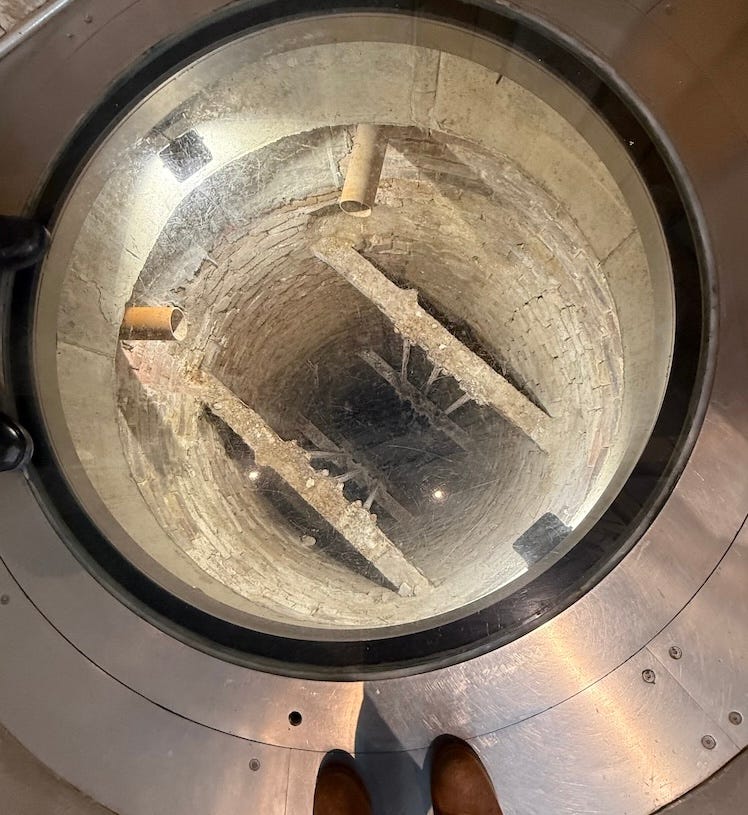


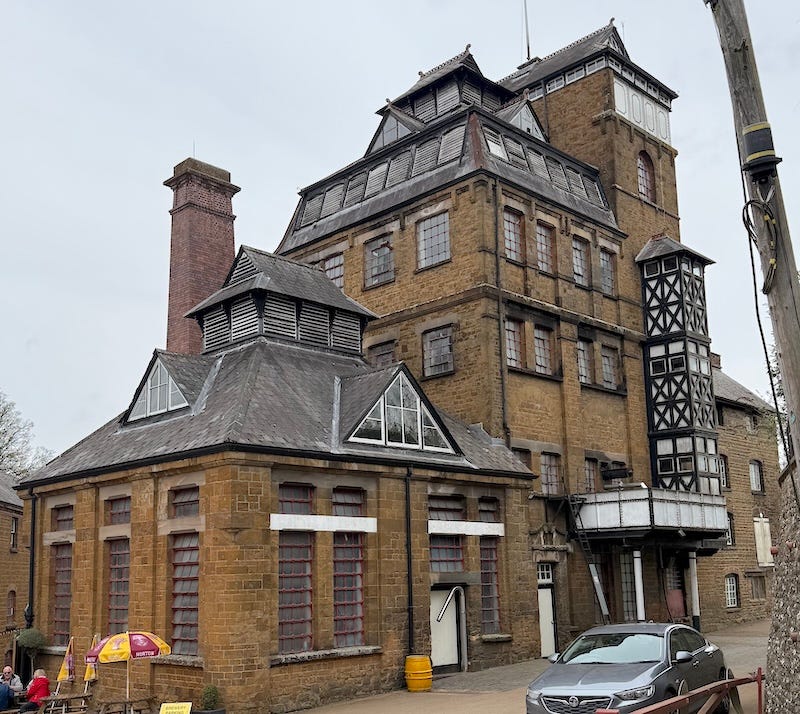


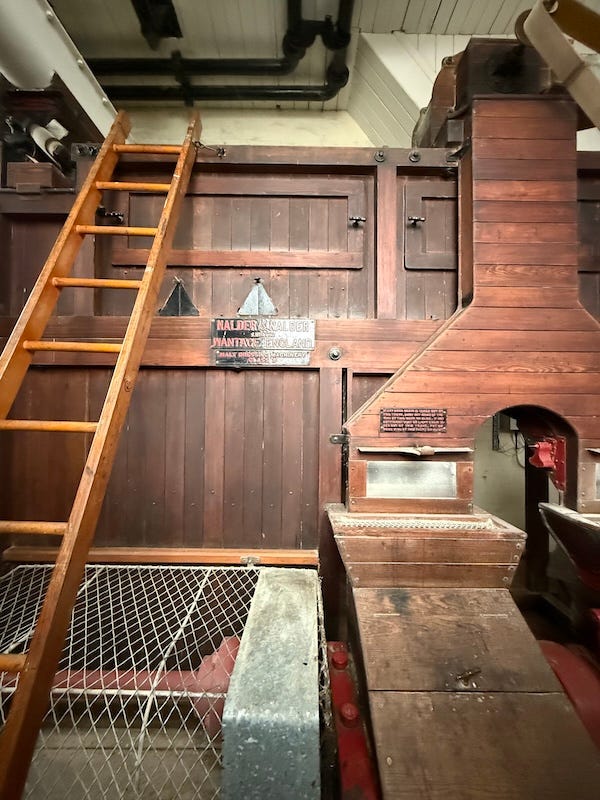


THANK YOU for putting this together for us! Wow, what a massive amount of work went into this. I love it all and can't wait to see what storytelling magic you alchemize from all this experience.